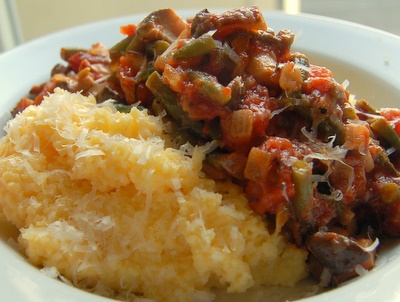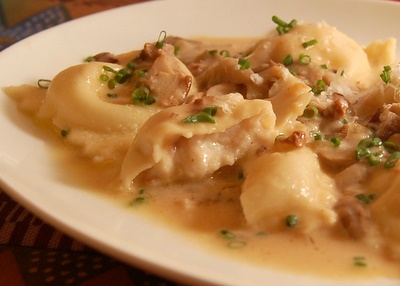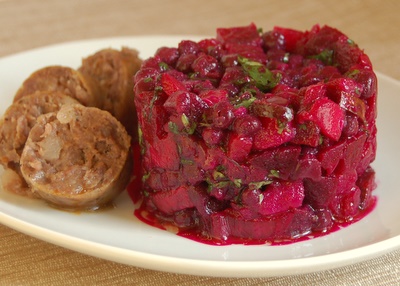 If you are a regular reader of this blog, you probably got so used to my misspellings, that you are thinking that I've even managed to misspell a title of a post. Ha-ha! Gotcha -- this time I did it on purpose. In Russia, "Vinegret" refers to the beet salad known as "Russian Salad" here in the US. Believe it or not, this salad is composed of about 30% beets and 70% other veggies, but you'd hardly notice by looking at it -- the beets have a way of dying everything magenta. I can't seem to find any information on the origin of this salad or its name. I am guessing that the name is the Russian spelling of the French "vinaigrette." This salad is in fact dressed with a vinaigrette type dressing used for many Russian salads, but in Russian, the word "Vinegret" refers exclusively to the salad made of beets.
If you are a regular reader of this blog, you probably got so used to my misspellings, that you are thinking that I've even managed to misspell a title of a post. Ha-ha! Gotcha -- this time I did it on purpose. In Russia, "Vinegret" refers to the beet salad known as "Russian Salad" here in the US. Believe it or not, this salad is composed of about 30% beets and 70% other veggies, but you'd hardly notice by looking at it -- the beets have a way of dying everything magenta. I can't seem to find any information on the origin of this salad or its name. I am guessing that the name is the Russian spelling of the French "vinaigrette." This salad is in fact dressed with a vinaigrette type dressing used for many Russian salads, but in Russian, the word "Vinegret" refers exclusively to the salad made of beets.I don't normally take pictures or write about what I make for lunch, but this salad came out so well, and the light in the kitchen was so wonderful that I decided to take a picture and post about it. I served it with the wild boar sausage that I got at Formaggio Kitchen on my way home from the gym. Good thing I don't stop by this store every time I go to the gym or it would defeat the purpose of exercising :)
I couldn't help laughing while stuffing this colorful salad into my ring mold. In Russia, this is as casual as food gets. You put a huge bowl on the table with some pumpernickel bread, butter, and herring (or sausages), and that's all the food styling this salad normally gets. But what won't an obsessed food blogger do to make it look more sexy for her readers?
Vinegret
Note on ingredients: Traditionally, cooks in Russia make this salad with canned peas. I find them really mushy and prefer to use frozen peas instead. I have also never heard of anyone using lemon juice to dress this salad. People either use vinegar or skip the acid ingredient all together. But although authenticity of my vinegret is questionable, the taste is not :)
Serves 4-6
For the salad:
2 medium beets (about 3" in diameter), washed, but not peeled
2 medium red-skinned potatoes (~ 3" in diameter), washed, but not peeled
1 large carrot, washed, but not peeled
1 large yellow onion, finely diced
2 large kosher dill pickles, finely diced
2 cups frozen peas
For the dressing:
2-3 Tbsp juice from pickles, or to taste
2-3 Tbsp freshly squeezed lemon juice, or to taste
1/3 cup sunflower seed oil (or olive oil)
Salt and black pepper to taste
For serving:
1/3 cup chopped cilantro, parsley, or dill
- Put beets, potatoes, and the carrot into a large pot, cover with cold water generously seasoned with salt, cover with lid, and bring to a boil. Reduce heat to medium-low, partially uncover, and simmer until the vegetables are tender, but not mushy. They'll have to be removed from the pot at different times. Test them by poking with a sharp knife. After the water comes to a boil, the carrot takes 20-30 minutes, potatoes take 30-40 minutes, and the beets take about an hour. Note that the beets never get as tender as potatoes, so if the knife pierces them relatively easily, they are done.
- Cook peas in boiling water just until defrosted, about 2 minutes. Drain and rinse with cold water to cool.
- Cool and peel the beets, potatoes, and carrot. Their skin will slide of pretty easily, so you don't need a peeler. Use a pairing knife for potatoes and carrot, and rub the beets with your hands to get the skin to slip off them.
- Cut all boiled vegetables into small dice and mix with onions, pickles, and peas.
- Dress the salad with pickle juice, lemon juice, sunflower seed oil, plenty of salt and pepper. Taste and adjust seasoning. Ideally, let the salad sit in the fridge overnight or at least for a few hours to let the flavors blend.
- Before serving, stir in cilantro, dill, or parsley. I like to drizzle each plate with a little more sunflower seed oil -- it's so good, I never seem to get enough of this stuff.

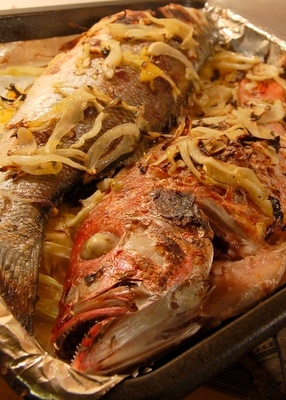 The moment Jason turned in his thesis last Wednesday, we got into our car and drove to Portland, ME. We spent 2 wonderful days sitting by the fire in our B&B, reading New York Times (I forgot how fun it is to read it on paper vs. on the monitor), and having the best meal of this year at
The moment Jason turned in his thesis last Wednesday, we got into our car and drove to Portland, ME. We spent 2 wonderful days sitting by the fire in our B&B, reading New York Times (I forgot how fun it is to read it on paper vs. on the monitor), and having the best meal of this year at 
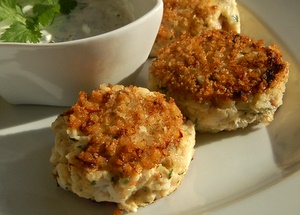
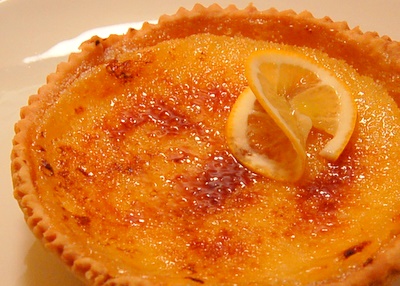 This Saturday, I've come to a conclusion that the most necessary tool in today's kitchen is not a KitchenAid mixer, a food processor, or a mandoline. It is, without a doubt, an internet connection. I never realized how much I rely on it until it was gone. After teaching for 3 days straight, and tidying up my kitchen after the last class, I was finally going to get to play with my beautiful meyer lemons. I got these little smooth beauties at Whole Foods a few days ago and couldn't get enough of them. I drizzled them over fish, put a slice in my tea each morning, and used them for salad dressings. They are a little sweeter and more perfumy than regular lemons and simply irresistable. I was thinking of dishes that would put meyer lemons center stage rather than use them as an accompaniment and came up with meyer lemon hollandaise sauce and meyer lemon tart.
This Saturday, I've come to a conclusion that the most necessary tool in today's kitchen is not a KitchenAid mixer, a food processor, or a mandoline. It is, without a doubt, an internet connection. I never realized how much I rely on it until it was gone. After teaching for 3 days straight, and tidying up my kitchen after the last class, I was finally going to get to play with my beautiful meyer lemons. I got these little smooth beauties at Whole Foods a few days ago and couldn't get enough of them. I drizzled them over fish, put a slice in my tea each morning, and used them for salad dressings. They are a little sweeter and more perfumy than regular lemons and simply irresistable. I was thinking of dishes that would put meyer lemons center stage rather than use them as an accompaniment and came up with meyer lemon hollandaise sauce and meyer lemon tart.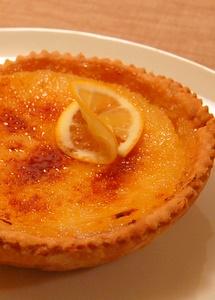

 There are two types of dishes in my kitchen -- the ones that I conceive and the ones that my leftovers conceive. I'd like to think that I am a pretty creative cook and am at least as good at this game as the little containers sitting in my fridge. But I have a feeling they go on long brainstorming sessions while sitting in the fridge for a day or two. I mean, if you were a leftover, how would you spend your time?
There are two types of dishes in my kitchen -- the ones that I conceive and the ones that my leftovers conceive. I'd like to think that I am a pretty creative cook and am at least as good at this game as the little containers sitting in my fridge. But I have a feeling they go on long brainstorming sessions while sitting in the fridge for a day or two. I mean, if you were a leftover, how would you spend your time?